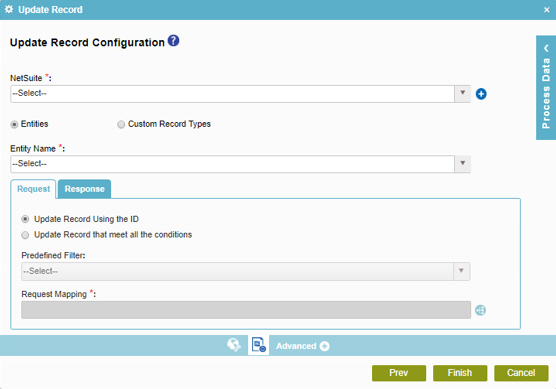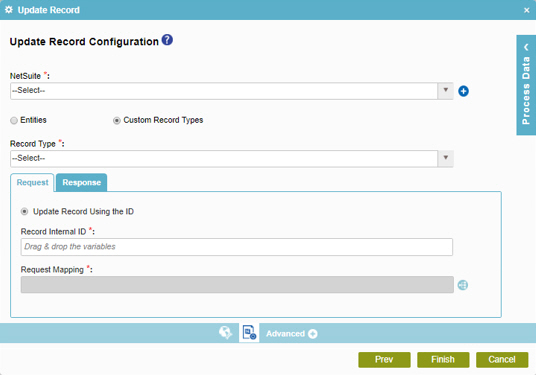|
NetSuite
|
- Function:
- Specifies the access token that connects to your
NetSuite application.
- Accepted Values:
- A list of access tokens configured for your environment.
- Default Value:
- None
- Example:
- Refer to:
|
|
Add Token 
|
- Opens this Screen:
- Access Tokens for NetSuite
- Function of this Screen:
- Configure an access token to connect to NetSuite.
- Example:
- Refer to:
|
|
Entities / Custom Record Types
|
- Function:
- Specifies whether to change a
record
for a standard NetSuite entity,
or a record for a custom record type.
- Accepted Values:
-
- Entities - Lets you select a standard NetSuite entity
in which to change the record.
- Custom Entities - Lets you select a custom record type
in which to change the record.
- Default Value:
- Entities
|
|
Entity Name
|
- Function:
- Specifies the name of an entity
for which to change the records.
- To Open this Field:
-
- On the Update Record Configuration screen,
select Entities.
- Accepted Values:
- An entity name from the list.
- Default Value:
- None.
When you select the NetSuite
access token, the name of entities show in the Entity Name field.
|
Record Type |
- Function:
- Specifies the name of a custom record type
for which to change the records.
- To Open this Field:
-
- On the Update Record Configuration screen,
click Custom Record Types.
- Accepted Values:
- A custom record type from the list.
- Default Value:
- None.
When you select the NetSuite access token,
the name of custom record types show in the Record Type field.
|
|
Update Record
|
- Function:
- Specifies how to change the records.
- To Open this Field:
-
- On the Update Record Configuration screen, click the Request tab.
- Accepted Values:
-
- Update Record Using the ID - Lets you connect a
NetSuite
record internal ID to your process schema to change a record.
- Update Record that meet all the conditions - Lets you specify
the name of a saved search from Predefined Filter list, and connect the NetSuite API request parameter to
your
schema
to change more than one record.
- Default Value:
- Update Record Using the ID
|
Predefined Filter |
- Function:
- Specifies the name of a saved search that exists in
NetSuite.
A saved search is a set of filters that specify
the data to get.
- To Open this Field:
-
- On the Update Record Configuration screen, click the Request tab.
- Click Update Record that meet all the conditions.
- Accepted Values:
- The name of a saved search in NetSuite.
- Default Value:
- None
|
|
Record Internal ID
|
- Function:
- Specifies the internal ID for the
record to change
in NetSuite.
The record internal ID comes from NetSuite.
- To Open this Field:
- On the Update Entity Configuration screen, click Custom Record Types.
- On the Request tab, click Update Record Using the ID.
- Accepted Values:
- An internal ID of the record from NetSuite.
- Default Value:
- None
- Accepts Process Data Variables:
- Yes
- Limitations:
-
Some information about
third-party integrations
is outside the scope of the AgilePoint NX Product Documentation, and it is the responsibility
of the vendors who create and maintain these technologies to provide this information.
This
includes specific business uses cases and examples; explanations
for third-party concepts; details about the data models and input and output
data formats for third-party technologies; and
various types of IDs, URL patterns, connection string formats,
and other technical information that is specific
to the
third-party technologies.
For more information, refer to
Where Can I Find Information and Examples for Third-Party Integrations?
|
|
Request Mapping
|
- Function:
- Connects the NetSuite API request parameter to your schema. This is mandatory only if the request passes data from the process schema to parameters in the NetSuite API.
- To Open this Field:
-
- On the
Update Entity Configuration screen,
click the Request tab.
- Accepted Values:
- Click the Schema Mapping
 button to open the
Schema Mapper. button to open the
Schema Mapper.
Use this screen to connect the request to the data model for your process.
- Default Value:
- None
- Limitations:
-
Some information about
third-party integrations
is outside the scope of the AgilePoint NX Product Documentation, and it is the responsibility
of the vendors who create and maintain these technologies to provide this information.
This
includes specific business uses cases and examples; explanations
for third-party concepts; details about the data models and input and output
data formats for third-party technologies; and
various types of IDs, URL patterns, connection string formats,
and other technical information that is specific
to the
third-party technologies.
For more information, refer to
Where Can I Find Information and Examples for Third-Party Integrations?
|
|
Map Response to AgilePoint Schema
|
- Function:
- Specifies the connection from the NetSuite API response parameter to your schema.
- To Open this Field:
-
- On the
Update Entity Configuration screen,
click the Response tab.
- Accepted Values:
- Click the Schema Mapping
 button to open the
Schema Mapper. button to open the
Schema Mapper.
Use this screen to connect the response to the data model for your process.
- Default Value:
- None
- Limitations:
-
Some information about
third-party integrations
is outside the scope of the AgilePoint NX Product Documentation, and it is the responsibility
of the vendors who create and maintain these technologies to provide this information.
This
includes specific business uses cases and examples; explanations
for third-party concepts; details about the data models and input and output
data formats for third-party technologies; and
various types of IDs, URL patterns, connection string formats,
and other technical information that is specific
to the
third-party technologies.
For more information, refer to
Where Can I Find Information and Examples for Third-Party Integrations?
|
|
Store the Response in Custom Attribute
|
- Function:
- Specifies the process data variable that contains the record internal ID from NetSuite.
- To Open this Field:
-
- On the
Update Entity Configuration screen,
click the Response tab.
- Accepted Values:
- A process data variable
that accepts a numeric string with no spaces
or special characters.
- Default Value:
- None
- Accepts Process Data Variables:
- Yes
- Limitations:
-
Some information about
third-party integrations
is outside the scope of the AgilePoint NX Product Documentation, and it is the responsibility
of the vendors who create and maintain these technologies to provide this information.
This
includes specific business uses cases and examples; explanations
for third-party concepts; details about the data models and input and output
data formats for third-party technologies; and
various types of IDs, URL patterns, connection string formats,
and other technical information that is specific
to the
third-party technologies.
For more information, refer to
Where Can I Find Information and Examples for Third-Party Integrations?
|

 >
E-mail Notifications
>
E-mail Notifications  .
.  tab.
tab. tab,
drag the Update Record
tab,
drag the Update Record  activity onto your process.
activity onto your process.





